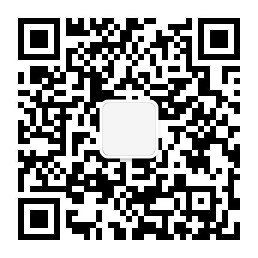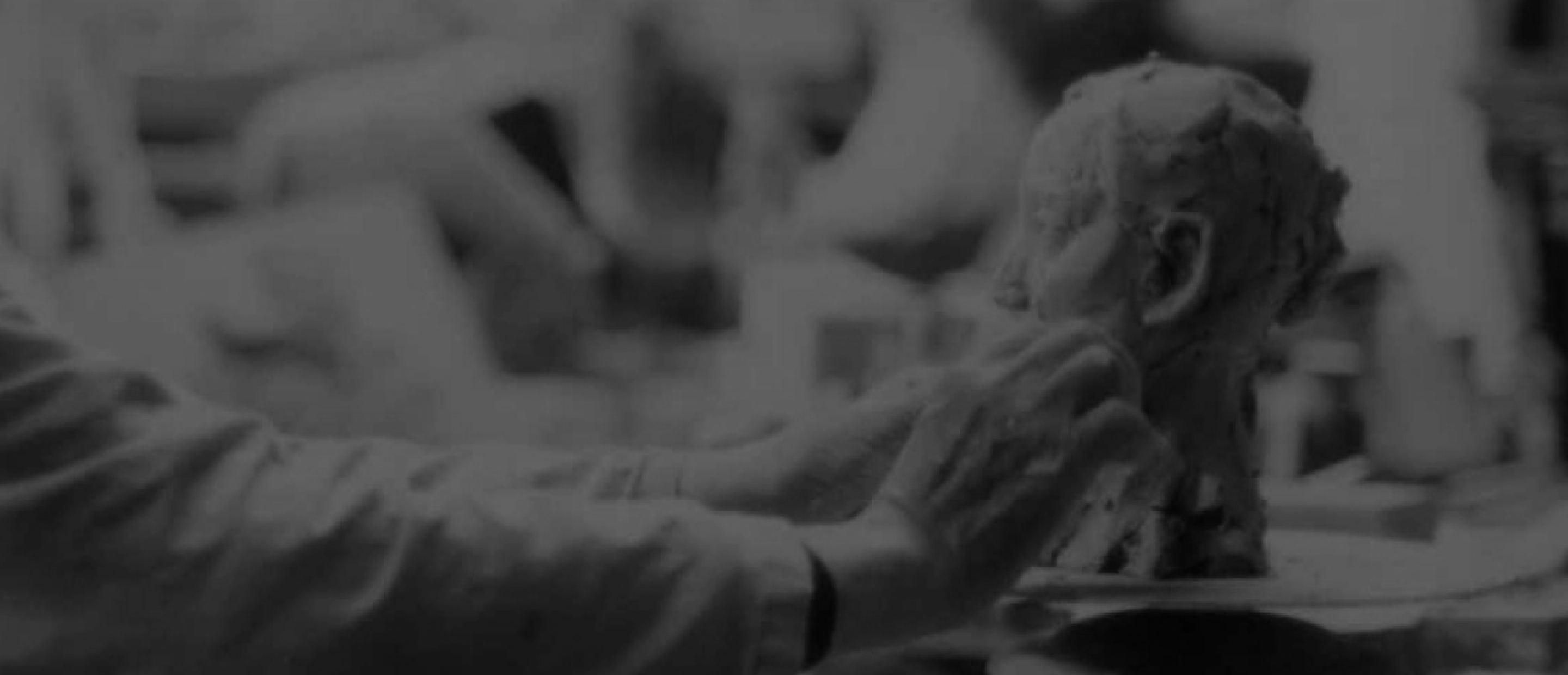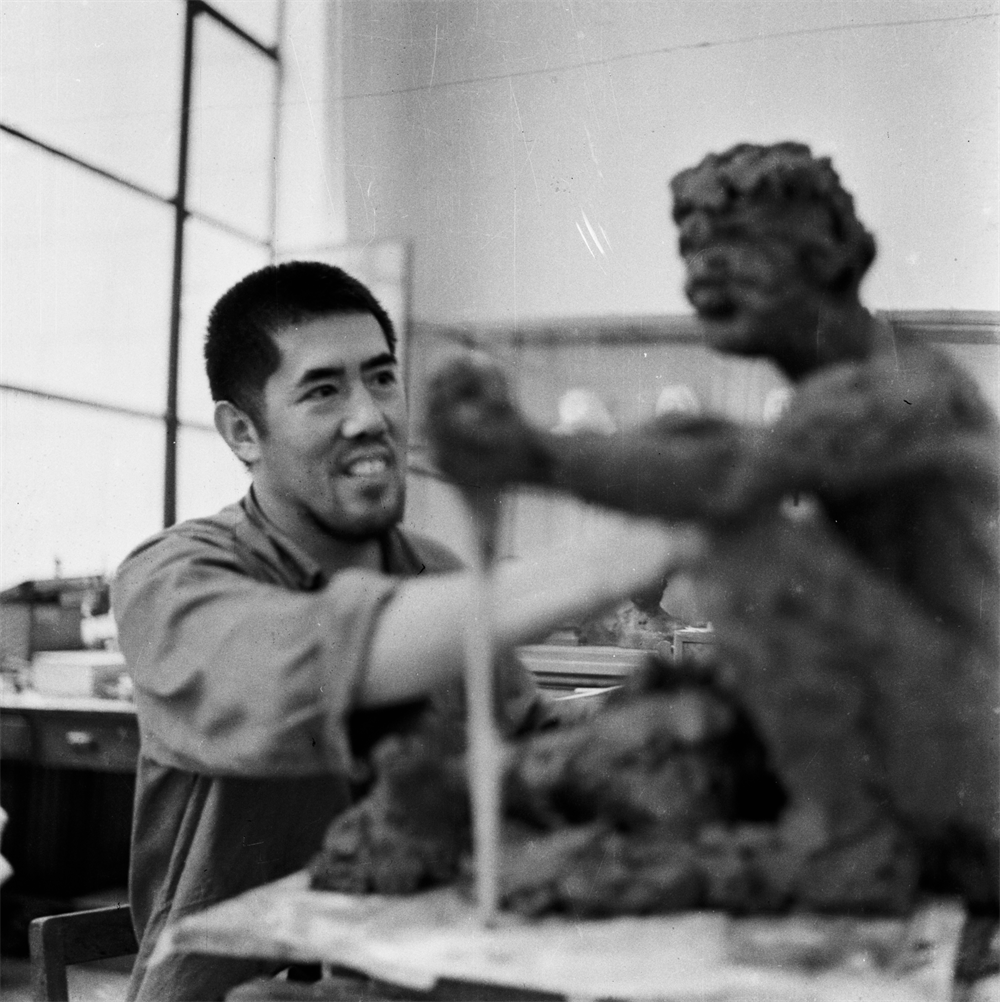About Liu Shiming
Born in Tianjin in 1926, Liu Shiming is one of the first generation of Chinese sculpture artists. His family of intellectuals allowed him to receive the traditional education of Chinese literati. In 1946, he was admitted to the National Art School in Beiping. In 1951, he graduated from the postgraduate class of the Sculpture Department at the Central Academy of Fine Arts (CAFA). He was one of the first generation of sculptors with a postgraduate background trained by the People’s Republic of China. Aside from the guidance of renowned masters such as Wang Linyi, Hua Tianyou and Zeng Zhushao, he also studied western art from sculptors of the first generation in the Sculpture Department of CAFA who once studied in France. In 1950, his school project “Measuring the Land” became the first sculpture sent abroad to be included in an exhibition after the founding of the People’s Republic of China, and was collected by the National Museum of Czechoslovak (now the Czech National Museum). In 1953, he was selected to the relief team for the Monument to the People’s Heroes in Tian’anmen, serving as the assistant to Prof. Liu Kaiqu and Prof. Wang Bingzhao, and he also participated in the drafting for the relief “Jintian Uprising”. In 1955, he was transferred to the China Sculpture Factory (later changed to the Sculpture Art Institute of CAFA) and completed many sculpture tasks such as the square sculpture of the Military Museum of The Chinese People’s Revolution and the main sculpture of the Beijing Workers’ Stadium. In 1959, his work “Splitting the Mountains to Let the Water Flow” (also known as “Moving Mountains and Making Sea”) was displayed on behalf of China in the “Plastic Arts Exhibition by Socialist Countries” held in the Soviet Union.
Since 1961 when Liu left Beijing, he has worked and lived in many places including Henan and Hebei. He has successively worked in the Art Department of Henan Kaifeng Normal College (now the Art Department of Henan University) and the Hebei Baoding Mass Culture and Art Museum, and he was once seconded to Henan Museum. During his experience with underprivileged people in Chinese society, Liu fully sensed their optimism and sincerity, which enable him to he embrace the major turning point in his art. He started to go deeper into the spiritual world of the Chinese people, expressing his humanistic feelings as a Chinese sculptor. Exactly, what makes Liu’s works the most valuable is his life philosophy of peace and the warmth for humanity.
After 1974, he retired early and returned to Beijing. Later, he worked in the National Museum of Chinese History (now the National Museum of China) for more than ten years on the restoration of cultural relics, which provided him with direct access to a large number of original traditional Chinese sculptures. This job had a great influence on Liu’s style. In 1980, Liu returned to CAFA as a teaching staff member, which motivated him a lot and he therefore embraced a peak period of creation.
Affected by his job in the National Museum of Chinese History, Liu drew on ancient pottery techniques and reproduced the contemporary life. What he created includes the people and scenes that he had seen, experienced, and engraved in his mind, being totally unconstrained and emotion-driven. Liu hardly drew sketches before sculpting, let alone using photos. Instead, he would repeatedly recall the impressive images or scenes in his memory and quickly shape them out of clay, almost finished in one sitting. His technique remained simple yet lively as well as concise, attaching more significance to the liveliness and vibe. Therefore, most of his works are simple and plain but full of emotion and childishness.
As Prof. Shao Dazhen wrote, “He depicts boatmen, farmers, shepherds, old women, and children, vividly presenting their demeanor and character as well as scenes from their life, but without making a caricature of them or seeking novelty. It seems that he never praises or criticizes people and scenes, and he only narrates them in a peaceful and objective way. However, what he tells or presents has been selected and refined, but he quietly hides himself behind his work, while integrating himself into the sculptures full of the passion for life. He integrates his simple and sincere feelings into the images he creates and the tones of his clay sculptures. All his works are just like the best wine that has been stored in an underground cellar for many years, enough to capture some land in our hearts.”
● Liu Shiming Sculpture Museum
On June 28th, 2018, Liu Shiming Sculpture Museum was established at the Xiaoying Campus of the Central Academy of Fine Arts.
● Solo Exhibitions
1. In 1982, “The Calligraphy, Painting and Sculpture Exhibition by Qian Shaowu, Liu Xiaocen, Wang Peng, Liu Shiming” was held at CAFA.
2. In 1998, “Liu Shiming Exhibition” was held at the Corridor Gallery of CAFA.
3. In 2005, the “Indigenous Sculptures: Liu Shiming Solo Exhibition” was held at the Sculpture Art Institute of CAFA.
4. In 2006, “Liberal Wormwood—Liu Shiming’s Solo Exhibition of Sculptures” was held at the National Art Museum of China.
5. In 2008, “Dream Back Home: Liu Shiming’s Solo Exhibition of Sculptures” was held in Henan Art Museum.
6. In October 2019, “Departure and Return: Liu Shiming’s Sculpture” was held at the Asian Cultural Center (New York) in the United States.
7. In November 2019, “Kindness Expresses Truth and Love: Liu Shiming’s Sculpture” was held at the Asian Fusion Gallery (Washington) in the United States.
8. In December 2019, “Souls in the Clay: Liu Shiming’s Sculpture” was held at the Liu Shiming Sculpture Museum of CAFA.
9. In January 2020, “Liu Shiming: A Chinese Original” New Year Sculpture Exhibition was held at The Oculus, World Trade Center in New York, USA.
● Group Exhibitions
1. In 1950, “Measuring the Land” was exhibited in the “Prague: World Student Gathering Art Exhibition”.2. In 1951, the “Volunteers Capturing the Wounded US Soldier” was exhibited in the Xinhua Bookstore in Wangfujing, Beijing.
3. In 1959, the “Splitting the Mountains to Let the Water Flow” was exhibited in the “Plastic Arts Exhibition by Socialist Countries”.
4. In 1966, he created the “Jiao Yulu” statue for the “Jiao Yulu Exhibition” in Zhengzhou.
5. In 1984, the “Cormorants” was selected for the 6th National Exhibition of Fine Arts.
6. In 1984, the “Towards the Sun” was selected for the “National Sculpture Design Exhibition”.
7. In 1986, the “Under the Tree” was selected for the “July 1st Art Exhibition”.
8. In 1988, “The Soaring Yellow River” and “Silk Road: The Camel” were selected for the “Gansu Urban Sculpture Planning Exhibition”.
9. In 1989, the work “Ansai Waist Drummer” was selected for the 7th National Exhibition of Fine Arts.
10. In 1990, the “Practicing Child” was selected for the Asian Games Art Exhibition.
11. In 1992, the “Eternal Love: The Continuation of Life” was selected for the Art Exhibition for the 50thAnniversary of the “Speech at the Yan’an Forum of Literature and Art”.
12. In 1993, the “Boatmen on the Yellow River” was selected for the 8th National Exhibition of Fine Arts.
13. In 1997, the work “The Boat on Yellow River” was selected for the “National Ceramic Art Touring Exhibition” and “European Touring Exhibition”.
14. In 1999, the “Mother” was selected for the 9th National Exhibition of Fine Arts.
15. In 2000, his work was selected for the exhibition program at Tsinghua University, which included a series of large-scale painting and calligraphy activities celebrating the 90th anniversary of Tsinghua University.
16. In 2001, his work was selected for the “Contemporary Artists Exhibition” at the National Museum of Chinese History.
17. In 2001, his work was selected for “The Fifth National Sports Art Exhibition”.
18. In 2002, his work was selected for the “2002 China Beijing International Urban Sculpture Exhibition”
19. In 2009, the work “Man with Boat and Cormorants” was selected for the “Cornerstone: Developments in 60 Years” Exhibition of Oil Painting, Sculpture and Printmaking.
20. In 2014, the “Splitting the Mountains to Let the Water Flow” was exhibited in the “Painting the Chinese Dream: An Exhibition Celebrating the 65th Anniversary of the People’s Republic of China”.
21. In 2015, the works “Boatmen on the Yellow River” and “Mountain Ghost” were exhibited at the “Where to Go” Sculpture Exhibition by Shanghai Oil Painting and Sculpture Institute.
22. In 2020, the works “Boatmen on the Yellow River” and “Sheepskin Raft” were exhibited at the large-scale contemporary art exhibition “The Endless Life: The Narrative of the Yellow River”.
23. In 2021, the works “Splitting the Mountains to Let the Water Flow”, “Sheepskin Raft” and other works were exhibited at the “The Greatest Changes in the Past 100 Years”: The Sculpture Artworks Exhibition at the National Museum of China.
● Collections
1. In 1950, his graduation project “Measuring the Land” was collected by the National Museum of Czechoslovak (now the Czech National Museum).
2. In 1952, the small-size stone sculpture “Discharged from the Hospital” was collected by the National Art Museum of China.
3. In 1955, the works “Bust of Monk Yixing” and “Bust of Zu Chongzhi” were collected by the National Museum of Chinese History.
4. In 1959, the group sculpture “Shared Labor of Officers and Soldiers” and the statue “Henan Jiyuan Militia Crossing the River” were collected by the Military Museum of The Chinese People’s Revolution.
5. In 1959, the work “Splitting the Mountains to Let the Water Flow” was collected by Baoding Municipal Government.
6. In 1985, the stone sculpture “Archer” was collected by Beijing Shijingshan Sculpture Park.
7. In 1997, the work “Boatmen on the Yellow River” was collected by the Ministry of Culture.
8. In 1999, his works “Ansai Waist Drummer”, “Splitting the Mountains to Let the Water Flow” and “Thick-back Woman” were collected by the National Museum of Chinese History.
9. In 2008, his works “Boatmen on the Yellow River” and “Performer Backstage” were collected by Henan Art Museum.
10. In 2012, the work “Performer Backstage” was collected by the National Centre for the Performing Arts.
11. In 2014, the work “Splitting the Mountains to Let the Water Flow” was collected by the National Art Museum of China.
12. In 2021, “Splitting the Mountains to Let the Water Flow”, “Sheepskin Raft”, “Three Donkeys” and “Man with Boat and Cormorants” were collected by the National Museum of China.
● Awards
1. In 1950, the work “Measuring the Land” won the first prize of the “Red May Art Exhibition” of the Central Academy of Fine Arts.
2. 1986, International Art Competition: New York.
3. In 1995, he was awarded the qualification certificate of “National Urban Sculpture Design” and was granted the State Council Honorary Allowance for Special Contribution.
4. In 2000, he won the “Award for 50-Year Active Contribution in Literature and Art” issued by the Beijing Municipal Party Committee.
5. In 2002, he won the certificates of “China Beijing International Urban Sculpture Exhibition” and “Half-Century Beijing Sculpture Art Documentary Exhibition.”
6. In 2002, he was awarded the honorary certificate and medal of “Chinese Century Talents” by the Ministry of Culture.
7. In 2009, he was awarded the “Award for 60-Year Active Contribution in Literature and Art” by the China Federation of Literary and Art Circles.
● Works Collected in Major Catalogues
1. In 2000, his work “Cormorants on the Yellow River” was selected to be included in the book Chinese Art Today.
2. In 1999, his work was included in the art of 20th Century Chinese Urban Sculpture.
3. In 1999, his work was included in the Beijing Urban Sculptures over 50 Years.
4. In 2000, his work was included in the 21st Century Talent Pool.
5. In 2001, his work was included in the compilation of Chinese Contemporary Culture and Art Celebrities(Chinese Talent Pool: Literature and Art Volume).
6. In 2001, his work was included in the Chinese Contemporary Literary Artists.
7. In 2001, his work was included in the CD-ROM version of Catalogue of Contemporary Chinese Artists.
8. In 2002, his work was included in the Century Collector’s Edition of Experts of the People’s Republic of China.
9. In 2002, his work was included in the Art China: Chinese Art Documents Special.
10. In 2008, his work was included in the compilation of Memorabilia of Chinese Fine Arts.
11. In 2009, his work was included in the compilation of Pioneers of Seeking Truth: The Theory and Practice of the People’s Republic of China in the Sixty Years’ Development.
● Auction Records
Title: Ansai Waist Drummer
Final price: RMB89,600
Auction Company: Xiling Yinshe Auction Co., Ltd.
Date: 2008/06/30
Special Session: The First Contemporary Chinese Sculpture Session
Title: Man with Boat and Cormorants
Final price: RMB358,400
Auction Company: China Guardian
Date: 2010/11/23
Special Session: Chinese Sculpture Series: Sculptures from Beijing and Tianjin
Title: Splitting the Mountains to Let the Water Flow
Final price: RMB80,500
Auction Company: Beijing Hanhai
Date: 2013/12/07
Special Session: Happiness in Mind: The Collection of Illustrations, Posters and Manuscripts
Title: Splitting the Mountains to Let the Water Flow
Final price: RMB667,000
Auction Company: Beijing Council
Date: 2015/12/04
Special Session: Treading the Waves: Session of 20th Century Modern Art in China
Title: Fusion
Final price: RMB713,000
Auction Company: China Guardian
Date: 2016/05/14
Special Session: Twentieth Century and Contemporary Art
Title: Silk Road
Final price: RMB943,000
Auction Company: China Guardian
Date: 2016/05/14
Special Session: Twentieth Century and Contemporary Art
Title: Yellow River Ballad
Final price: RMB34,500
Auction Company: Beijing Hanhai
Date: 2016/06/04
Special Session: Happiness in Mind: The Collection of Illustrations, Posters and Manuscripts
Title: Guangling Melody
Final price: RMB1,380,000
Auction Company: Beijing Council
Date: 2016/12/06
Special Session: The Path of the Forerunner: Modern Art in the 20th Century


